Leadership: Critical Analysis of Leadership Theories and Styles Report
VerifiedAdded on 2020/10/22
|30
|9985
|205
Report
AI Summary
This report provides a critical analysis of leadership, drawing on a literature review of ten articles in human resource management. It examines various leadership theories and styles, including behavioral, transformational, contingency, participative, servant, and autocratic approaches. The report explores the relationship between leadership and organizational creativity and innovation, highlighting the importance of context and culture. It delves into different leadership theories, such as the trait theory, and analyzes the impact of various leadership styles on employee motivation and organizational effectiveness. The report also discusses the application of these theories in different contexts, such as in relation to employee behavior and job satisfaction, and emphasizes the need for adaptability and clear communication in leadership.
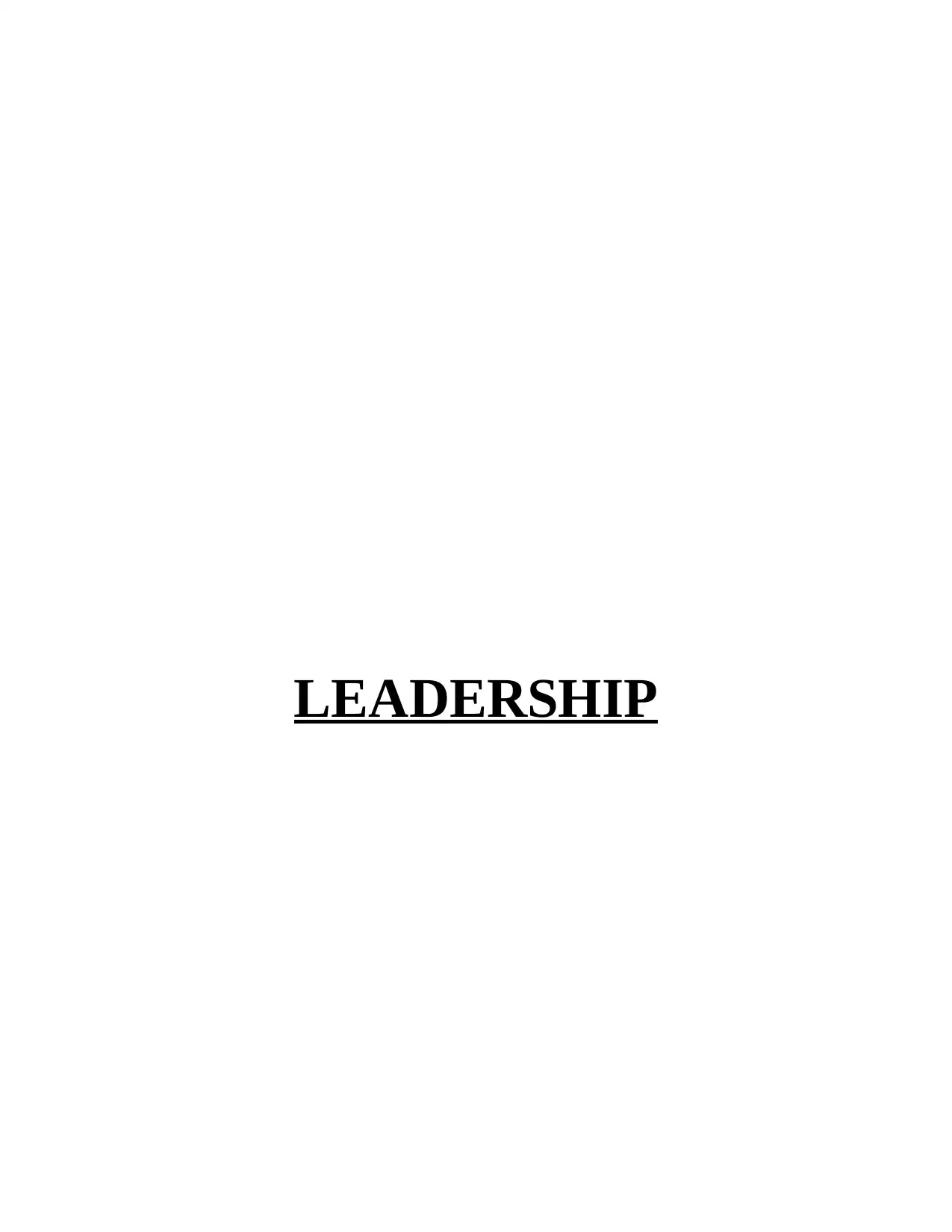
LEADERSHIP
Paraphrase This Document
Need a fresh take? Get an instant paraphrase of this document with our AI Paraphraser
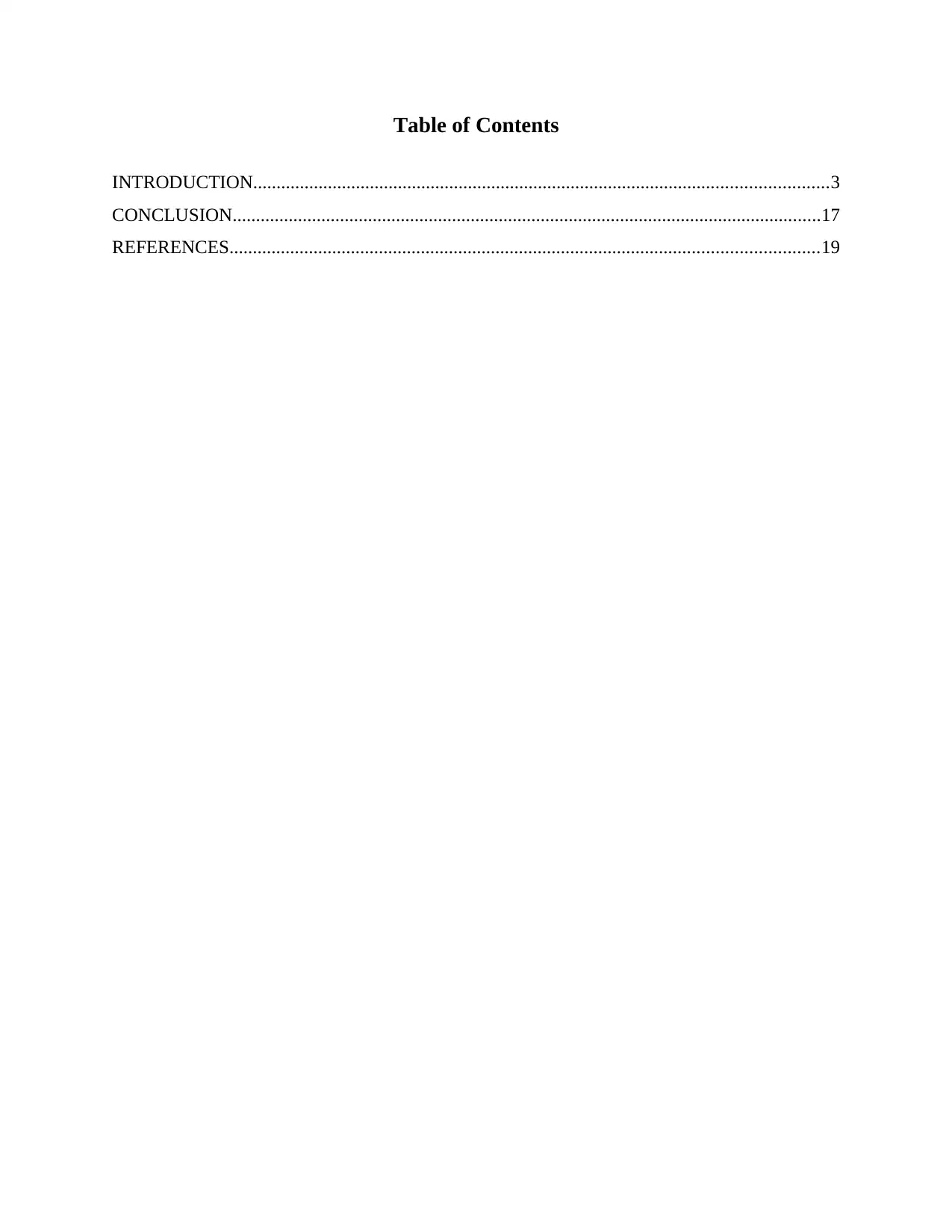
Table of Contents
INTRODUCTION...........................................................................................................................3
CONCLUSION..............................................................................................................................17
REFERENCES..............................................................................................................................19
INTRODUCTION...........................................................................................................................3
CONCLUSION..............................................................................................................................17
REFERENCES..............................................................................................................................19
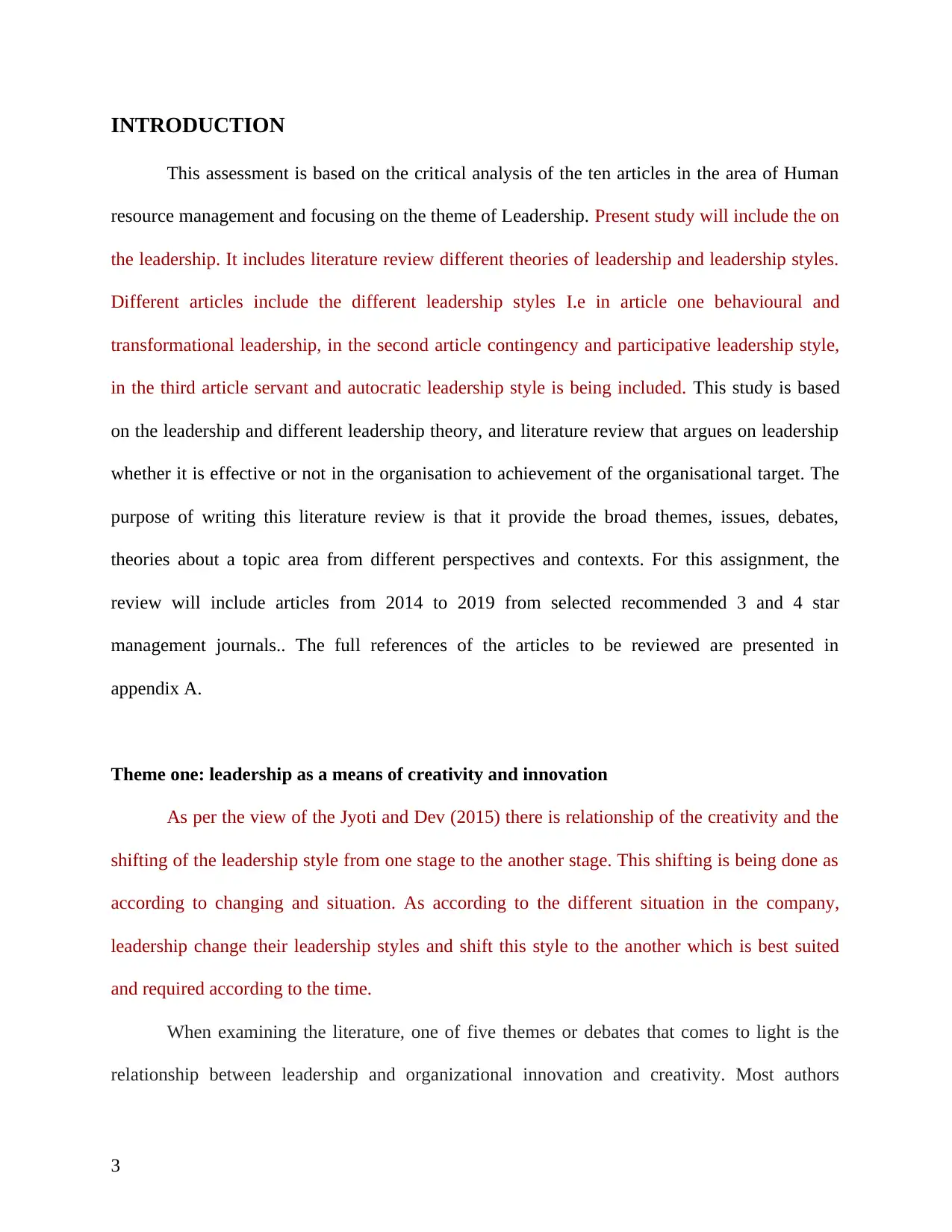
INTRODUCTION
This assessment is based on the critical analysis of the ten articles in the area of Human
resource management and focusing on the theme of Leadership. Present study will include the on
the leadership. It includes literature review different theories of leadership and leadership styles.
Different articles include the different leadership styles I.e in article one behavioural and
transformational leadership, in the second article contingency and participative leadership style,
in the third article servant and autocratic leadership style is being included. This study is based
on the leadership and different leadership theory, and literature review that argues on leadership
whether it is effective or not in the organisation to achievement of the organisational target. The
purpose of writing this literature review is that it provide the broad themes, issues, debates,
theories about a topic area from different perspectives and contexts. For this assignment, the
review will include articles from 2014 to 2019 from selected recommended 3 and 4 star
management journals.. The full references of the articles to be reviewed are presented in
appendix A.
Theme one: leadership as a means of creativity and innovation
As per the view of the Jyoti and Dev (2015) there is relationship of the creativity and the
shifting of the leadership style from one stage to the another stage. This shifting is being done as
according to changing and situation. As according to the different situation in the company,
leadership change their leadership styles and shift this style to the another which is best suited
and required according to the time.
When examining the literature, one of five themes or debates that comes to light is the
relationship between leadership and organizational innovation and creativity. Most authors
3
This assessment is based on the critical analysis of the ten articles in the area of Human
resource management and focusing on the theme of Leadership. Present study will include the on
the leadership. It includes literature review different theories of leadership and leadership styles.
Different articles include the different leadership styles I.e in article one behavioural and
transformational leadership, in the second article contingency and participative leadership style,
in the third article servant and autocratic leadership style is being included. This study is based
on the leadership and different leadership theory, and literature review that argues on leadership
whether it is effective or not in the organisation to achievement of the organisational target. The
purpose of writing this literature review is that it provide the broad themes, issues, debates,
theories about a topic area from different perspectives and contexts. For this assignment, the
review will include articles from 2014 to 2019 from selected recommended 3 and 4 star
management journals.. The full references of the articles to be reviewed are presented in
appendix A.
Theme one: leadership as a means of creativity and innovation
As per the view of the Jyoti and Dev (2015) there is relationship of the creativity and the
shifting of the leadership style from one stage to the another stage. This shifting is being done as
according to changing and situation. As according to the different situation in the company,
leadership change their leadership styles and shift this style to the another which is best suited
and required according to the time.
When examining the literature, one of five themes or debates that comes to light is the
relationship between leadership and organizational innovation and creativity. Most authors
3
⊘ This is a preview!⊘
Do you want full access?
Subscribe today to unlock all pages.

Trusted by 1+ million students worldwide
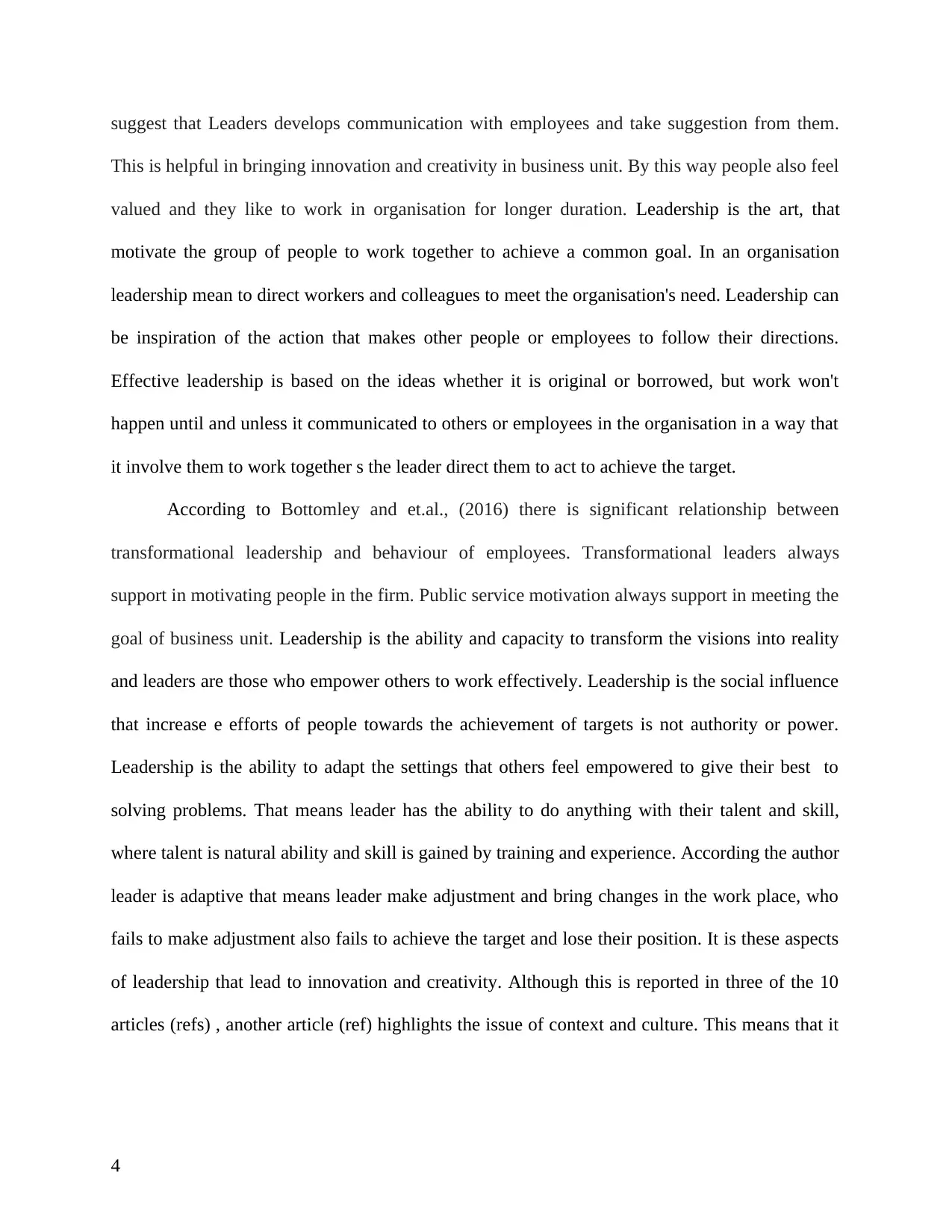
suggest that Leaders develops communication with employees and take suggestion from them.
This is helpful in bringing innovation and creativity in business unit. By this way people also feel
valued and they like to work in organisation for longer duration. Leadership is the art, that
motivate the group of people to work together to achieve a common goal. In an organisation
leadership mean to direct workers and colleagues to meet the organisation's need. Leadership can
be inspiration of the action that makes other people or employees to follow their directions.
Effective leadership is based on the ideas whether it is original or borrowed, but work won't
happen until and unless it communicated to others or employees in the organisation in a way that
it involve them to work together s the leader direct them to act to achieve the target.
According to Bottomley and et.al., (2016) there is significant relationship between
transformational leadership and behaviour of employees. Transformational leaders always
support in motivating people in the firm. Public service motivation always support in meeting the
goal of business unit. Leadership is the ability and capacity to transform the visions into reality
and leaders are those who empower others to work effectively. Leadership is the social influence
that increase e efforts of people towards the achievement of targets is not authority or power.
Leadership is the ability to adapt the settings that others feel empowered to give their best to
solving problems. That means leader has the ability to do anything with their talent and skill,
where talent is natural ability and skill is gained by training and experience. According the author
leader is adaptive that means leader make adjustment and bring changes in the work place, who
fails to make adjustment also fails to achieve the target and lose their position. It is these aspects
of leadership that lead to innovation and creativity. Although this is reported in three of the 10
articles (refs) , another article (ref) highlights the issue of context and culture. This means that it
4
This is helpful in bringing innovation and creativity in business unit. By this way people also feel
valued and they like to work in organisation for longer duration. Leadership is the art, that
motivate the group of people to work together to achieve a common goal. In an organisation
leadership mean to direct workers and colleagues to meet the organisation's need. Leadership can
be inspiration of the action that makes other people or employees to follow their directions.
Effective leadership is based on the ideas whether it is original or borrowed, but work won't
happen until and unless it communicated to others or employees in the organisation in a way that
it involve them to work together s the leader direct them to act to achieve the target.
According to Bottomley and et.al., (2016) there is significant relationship between
transformational leadership and behaviour of employees. Transformational leaders always
support in motivating people in the firm. Public service motivation always support in meeting the
goal of business unit. Leadership is the ability and capacity to transform the visions into reality
and leaders are those who empower others to work effectively. Leadership is the social influence
that increase e efforts of people towards the achievement of targets is not authority or power.
Leadership is the ability to adapt the settings that others feel empowered to give their best to
solving problems. That means leader has the ability to do anything with their talent and skill,
where talent is natural ability and skill is gained by training and experience. According the author
leader is adaptive that means leader make adjustment and bring changes in the work place, who
fails to make adjustment also fails to achieve the target and lose their position. It is these aspects
of leadership that lead to innovation and creativity. Although this is reported in three of the 10
articles (refs) , another article (ref) highlights the issue of context and culture. This means that it
4
Paraphrase This Document
Need a fresh take? Get an instant paraphrase of this document with our AI Paraphraser
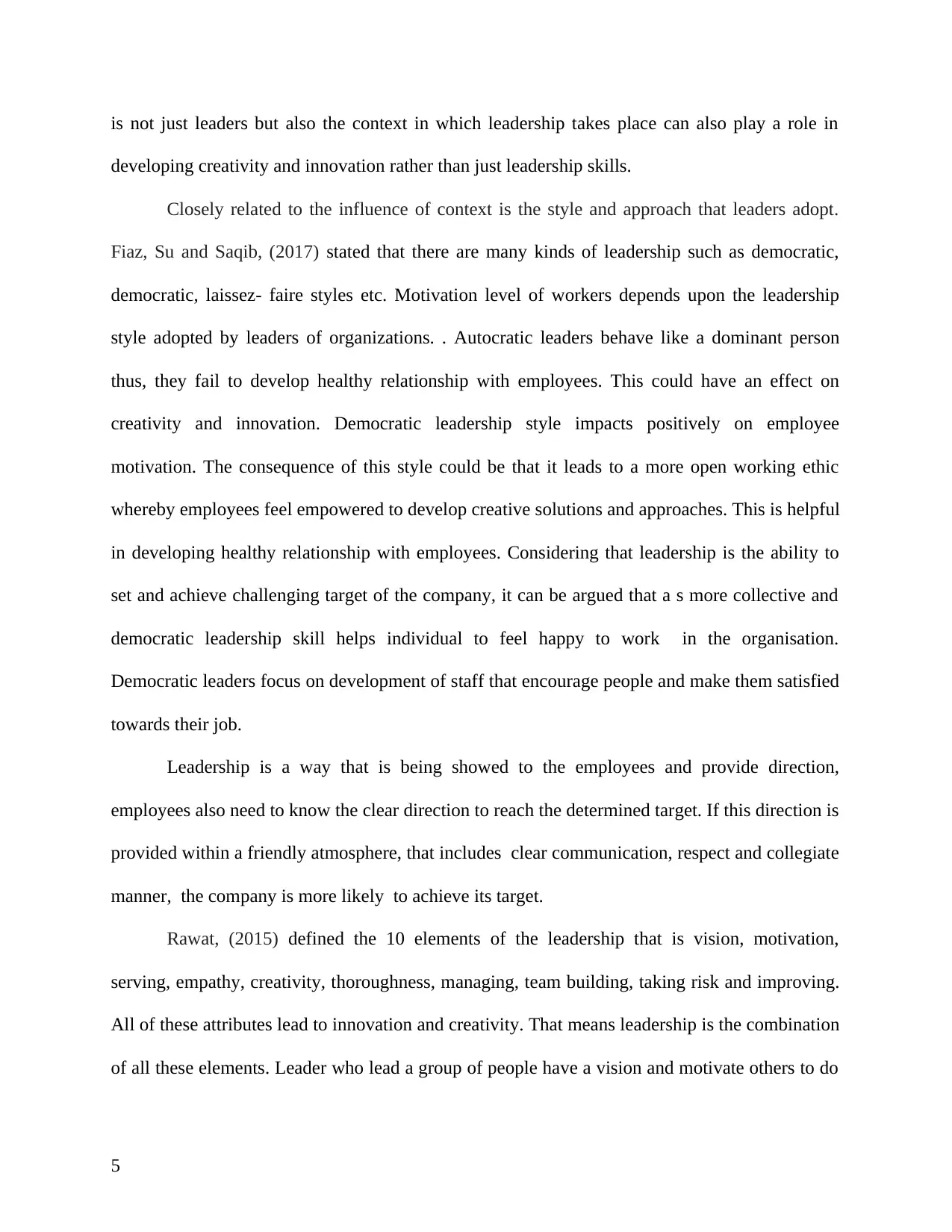
is not just leaders but also the context in which leadership takes place can also play a role in
developing creativity and innovation rather than just leadership skills.
Closely related to the influence of context is the style and approach that leaders adopt.
Fiaz, Su and Saqib, (2017) stated that there are many kinds of leadership such as democratic,
democratic, laissez- faire styles etc. Motivation level of workers depends upon the leadership
style adopted by leaders of organizations. . Autocratic leaders behave like a dominant person
thus, they fail to develop healthy relationship with employees. This could have an effect on
creativity and innovation. Democratic leadership style impacts positively on employee
motivation. The consequence of this style could be that it leads to a more open working ethic
whereby employees feel empowered to develop creative solutions and approaches. This is helpful
in developing healthy relationship with employees. Considering that leadership is the ability to
set and achieve challenging target of the company, it can be argued that a s more collective and
democratic leadership skill helps individual to feel happy to work in the organisation.
Democratic leaders focus on development of staff that encourage people and make them satisfied
towards their job.
Leadership is a way that is being showed to the employees and provide direction,
employees also need to know the clear direction to reach the determined target. If this direction is
provided within a friendly atmosphere, that includes clear communication, respect and collegiate
manner, the company is more likely to achieve its target.
Rawat, (2015) defined the 10 elements of the leadership that is vision, motivation,
serving, empathy, creativity, thoroughness, managing, team building, taking risk and improving.
All of these attributes lead to innovation and creativity. That means leadership is the combination
of all these elements. Leader who lead a group of people have a vision and motivate others to do
5
developing creativity and innovation rather than just leadership skills.
Closely related to the influence of context is the style and approach that leaders adopt.
Fiaz, Su and Saqib, (2017) stated that there are many kinds of leadership such as democratic,
democratic, laissez- faire styles etc. Motivation level of workers depends upon the leadership
style adopted by leaders of organizations. . Autocratic leaders behave like a dominant person
thus, they fail to develop healthy relationship with employees. This could have an effect on
creativity and innovation. Democratic leadership style impacts positively on employee
motivation. The consequence of this style could be that it leads to a more open working ethic
whereby employees feel empowered to develop creative solutions and approaches. This is helpful
in developing healthy relationship with employees. Considering that leadership is the ability to
set and achieve challenging target of the company, it can be argued that a s more collective and
democratic leadership skill helps individual to feel happy to work in the organisation.
Democratic leaders focus on development of staff that encourage people and make them satisfied
towards their job.
Leadership is a way that is being showed to the employees and provide direction,
employees also need to know the clear direction to reach the determined target. If this direction is
provided within a friendly atmosphere, that includes clear communication, respect and collegiate
manner, the company is more likely to achieve its target.
Rawat, (2015) defined the 10 elements of the leadership that is vision, motivation,
serving, empathy, creativity, thoroughness, managing, team building, taking risk and improving.
All of these attributes lead to innovation and creativity. That means leadership is the combination
of all these elements. Leader who lead a group of people have a vision and motivate others to do
5
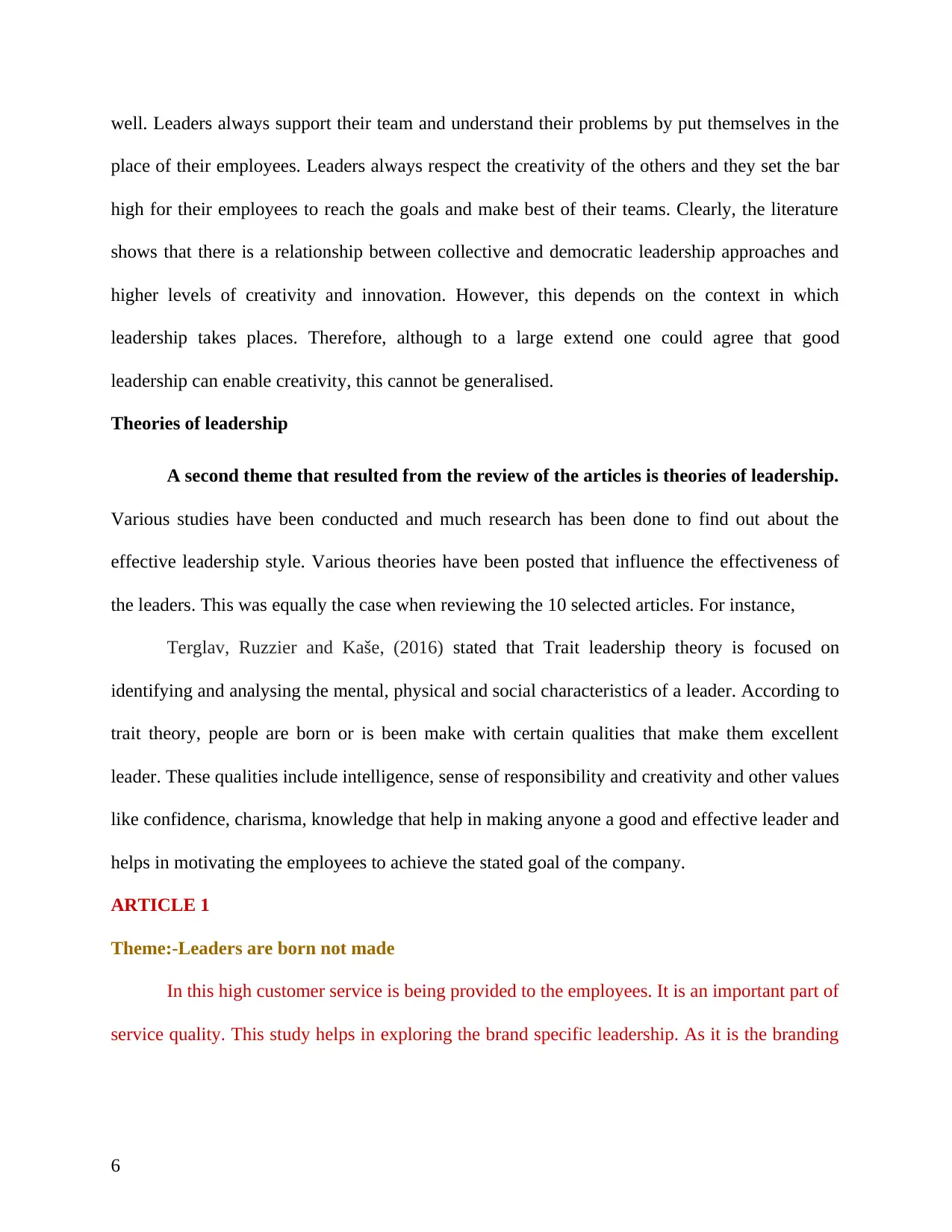
well. Leaders always support their team and understand their problems by put themselves in the
place of their employees. Leaders always respect the creativity of the others and they set the bar
high for their employees to reach the goals and make best of their teams. Clearly, the literature
shows that there is a relationship between collective and democratic leadership approaches and
higher levels of creativity and innovation. However, this depends on the context in which
leadership takes places. Therefore, although to a large extend one could agree that good
leadership can enable creativity, this cannot be generalised.
Theories of leadership
A second theme that resulted from the review of the articles is theories of leadership.
Various studies have been conducted and much research has been done to find out about the
effective leadership style. Various theories have been posted that influence the effectiveness of
the leaders. This was equally the case when reviewing the 10 selected articles. For instance,
Terglav, Ruzzier and Kaše, (2016) stated that Trait leadership theory is focused on
identifying and analysing the mental, physical and social characteristics of a leader. According to
trait theory, people are born or is been make with certain qualities that make them excellent
leader. These qualities include intelligence, sense of responsibility and creativity and other values
like confidence, charisma, knowledge that help in making anyone a good and effective leader and
helps in motivating the employees to achieve the stated goal of the company.
ARTICLE 1
Theme:-Leaders are born not made
In this high customer service is being provided to the employees. It is an important part of
service quality. This study helps in exploring the brand specific leadership. As it is the branding
6
place of their employees. Leaders always respect the creativity of the others and they set the bar
high for their employees to reach the goals and make best of their teams. Clearly, the literature
shows that there is a relationship between collective and democratic leadership approaches and
higher levels of creativity and innovation. However, this depends on the context in which
leadership takes places. Therefore, although to a large extend one could agree that good
leadership can enable creativity, this cannot be generalised.
Theories of leadership
A second theme that resulted from the review of the articles is theories of leadership.
Various studies have been conducted and much research has been done to find out about the
effective leadership style. Various theories have been posted that influence the effectiveness of
the leaders. This was equally the case when reviewing the 10 selected articles. For instance,
Terglav, Ruzzier and Kaše, (2016) stated that Trait leadership theory is focused on
identifying and analysing the mental, physical and social characteristics of a leader. According to
trait theory, people are born or is been make with certain qualities that make them excellent
leader. These qualities include intelligence, sense of responsibility and creativity and other values
like confidence, charisma, knowledge that help in making anyone a good and effective leader and
helps in motivating the employees to achieve the stated goal of the company.
ARTICLE 1
Theme:-Leaders are born not made
In this high customer service is being provided to the employees. It is an important part of
service quality. This study helps in exploring the brand specific leadership. As it is the branding
6
⊘ This is a preview!⊘
Do you want full access?
Subscribe today to unlock all pages.

Trusted by 1+ million students worldwide
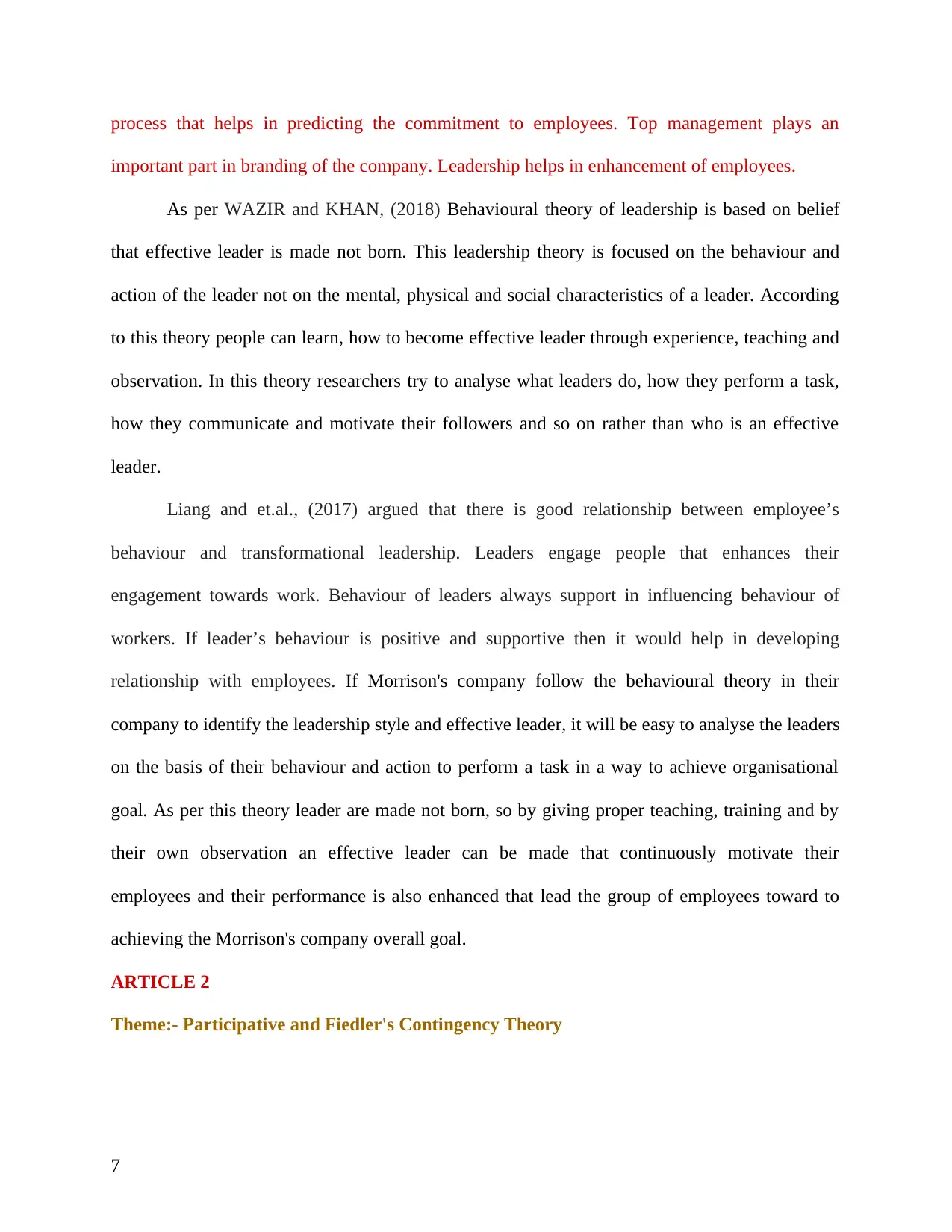
process that helps in predicting the commitment to employees. Top management plays an
important part in branding of the company. Leadership helps in enhancement of employees.
As per WAZIR and KHAN, (2018) Behavioural theory of leadership is based on belief
that effective leader is made not born. This leadership theory is focused on the behaviour and
action of the leader not on the mental, physical and social characteristics of a leader. According
to this theory people can learn, how to become effective leader through experience, teaching and
observation. In this theory researchers try to analyse what leaders do, how they perform a task,
how they communicate and motivate their followers and so on rather than who is an effective
leader.
Liang and et.al., (2017) argued that there is good relationship between employee’s
behaviour and transformational leadership. Leaders engage people that enhances their
engagement towards work. Behaviour of leaders always support in influencing behaviour of
workers. If leader’s behaviour is positive and supportive then it would help in developing
relationship with employees. If Morrison's company follow the behavioural theory in their
company to identify the leadership style and effective leader, it will be easy to analyse the leaders
on the basis of their behaviour and action to perform a task in a way to achieve organisational
goal. As per this theory leader are made not born, so by giving proper teaching, training and by
their own observation an effective leader can be made that continuously motivate their
employees and their performance is also enhanced that lead the group of employees toward to
achieving the Morrison's company overall goal.
ARTICLE 2
Theme:- Participative and Fiedler's Contingency Theory
7
important part in branding of the company. Leadership helps in enhancement of employees.
As per WAZIR and KHAN, (2018) Behavioural theory of leadership is based on belief
that effective leader is made not born. This leadership theory is focused on the behaviour and
action of the leader not on the mental, physical and social characteristics of a leader. According
to this theory people can learn, how to become effective leader through experience, teaching and
observation. In this theory researchers try to analyse what leaders do, how they perform a task,
how they communicate and motivate their followers and so on rather than who is an effective
leader.
Liang and et.al., (2017) argued that there is good relationship between employee’s
behaviour and transformational leadership. Leaders engage people that enhances their
engagement towards work. Behaviour of leaders always support in influencing behaviour of
workers. If leader’s behaviour is positive and supportive then it would help in developing
relationship with employees. If Morrison's company follow the behavioural theory in their
company to identify the leadership style and effective leader, it will be easy to analyse the leaders
on the basis of their behaviour and action to perform a task in a way to achieve organisational
goal. As per this theory leader are made not born, so by giving proper teaching, training and by
their own observation an effective leader can be made that continuously motivate their
employees and their performance is also enhanced that lead the group of employees toward to
achieving the Morrison's company overall goal.
ARTICLE 2
Theme:- Participative and Fiedler's Contingency Theory
7
Paraphrase This Document
Need a fresh take? Get an instant paraphrase of this document with our AI Paraphraser
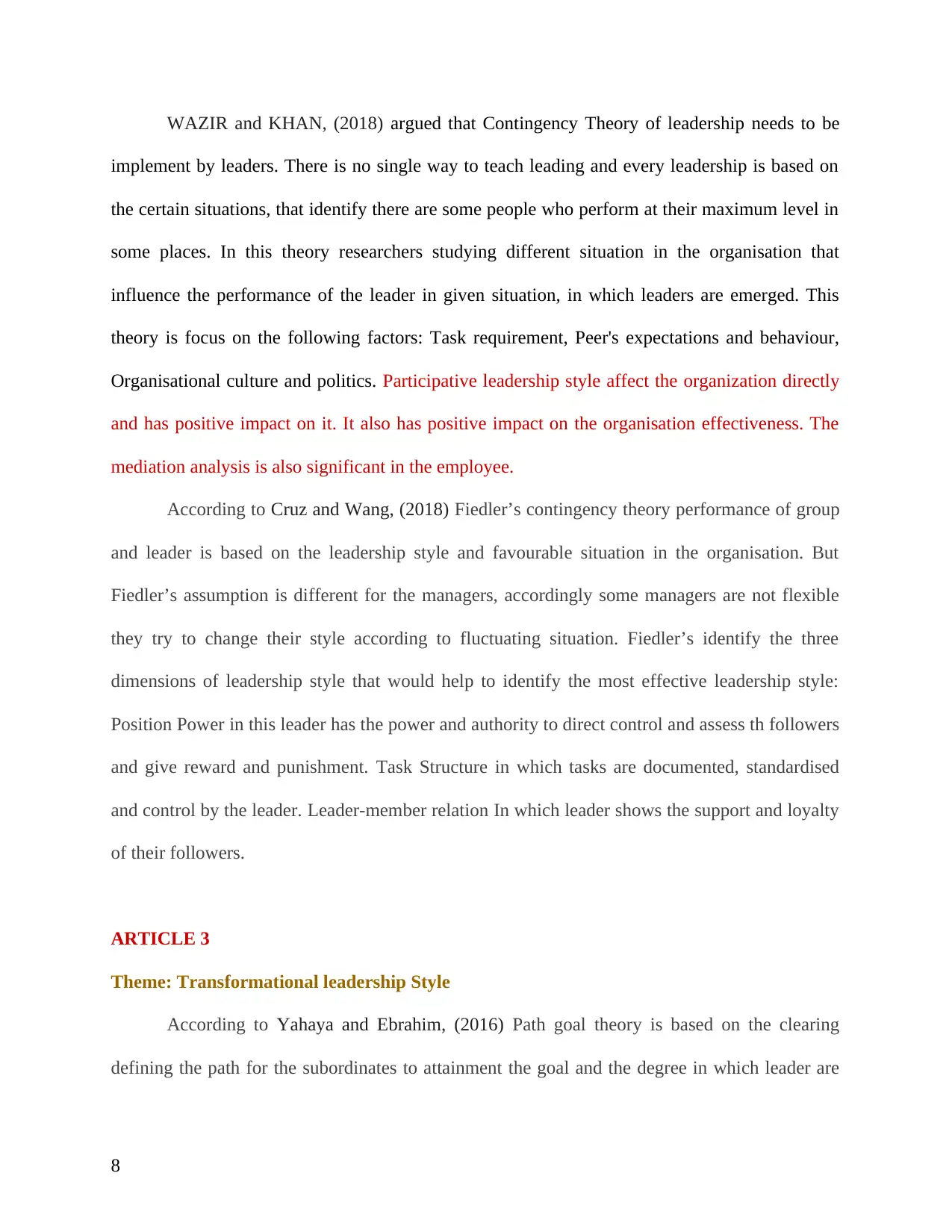
WAZIR and KHAN, (2018) argued that Contingency Theory of leadership needs to be
implement by leaders. There is no single way to teach leading and every leadership is based on
the certain situations, that identify there are some people who perform at their maximum level in
some places. In this theory researchers studying different situation in the organisation that
influence the performance of the leader in given situation, in which leaders are emerged. This
theory is focus on the following factors: Task requirement, Peer's expectations and behaviour,
Organisational culture and politics. Participative leadership style affect the organization directly
and has positive impact on it. It also has positive impact on the organisation effectiveness. The
mediation analysis is also significant in the employee.
According to Cruz and Wang, (2018) Fiedler’s contingency theory performance of group
and leader is based on the leadership style and favourable situation in the organisation. But
Fiedler’s assumption is different for the managers, accordingly some managers are not flexible
they try to change their style according to fluctuating situation. Fiedler’s identify the three
dimensions of leadership style that would help to identify the most effective leadership style:
Position Power in this leader has the power and authority to direct control and assess th followers
and give reward and punishment. Task Structure in which tasks are documented, standardised
and control by the leader. Leader-member relation In which leader shows the support and loyalty
of their followers.
ARTICLE 3
Theme: Transformational leadership Style
According to Yahaya and Ebrahim, (2016) Path goal theory is based on the clearing
defining the path for the subordinates to attainment the goal and the degree in which leader are
8
implement by leaders. There is no single way to teach leading and every leadership is based on
the certain situations, that identify there are some people who perform at their maximum level in
some places. In this theory researchers studying different situation in the organisation that
influence the performance of the leader in given situation, in which leaders are emerged. This
theory is focus on the following factors: Task requirement, Peer's expectations and behaviour,
Organisational culture and politics. Participative leadership style affect the organization directly
and has positive impact on it. It also has positive impact on the organisation effectiveness. The
mediation analysis is also significant in the employee.
According to Cruz and Wang, (2018) Fiedler’s contingency theory performance of group
and leader is based on the leadership style and favourable situation in the organisation. But
Fiedler’s assumption is different for the managers, accordingly some managers are not flexible
they try to change their style according to fluctuating situation. Fiedler’s identify the three
dimensions of leadership style that would help to identify the most effective leadership style:
Position Power in this leader has the power and authority to direct control and assess th followers
and give reward and punishment. Task Structure in which tasks are documented, standardised
and control by the leader. Leader-member relation In which leader shows the support and loyalty
of their followers.
ARTICLE 3
Theme: Transformational leadership Style
According to Yahaya and Ebrahim, (2016) Path goal theory is based on the clearing
defining the path for the subordinates to attainment the goal and the degree in which leader are
8
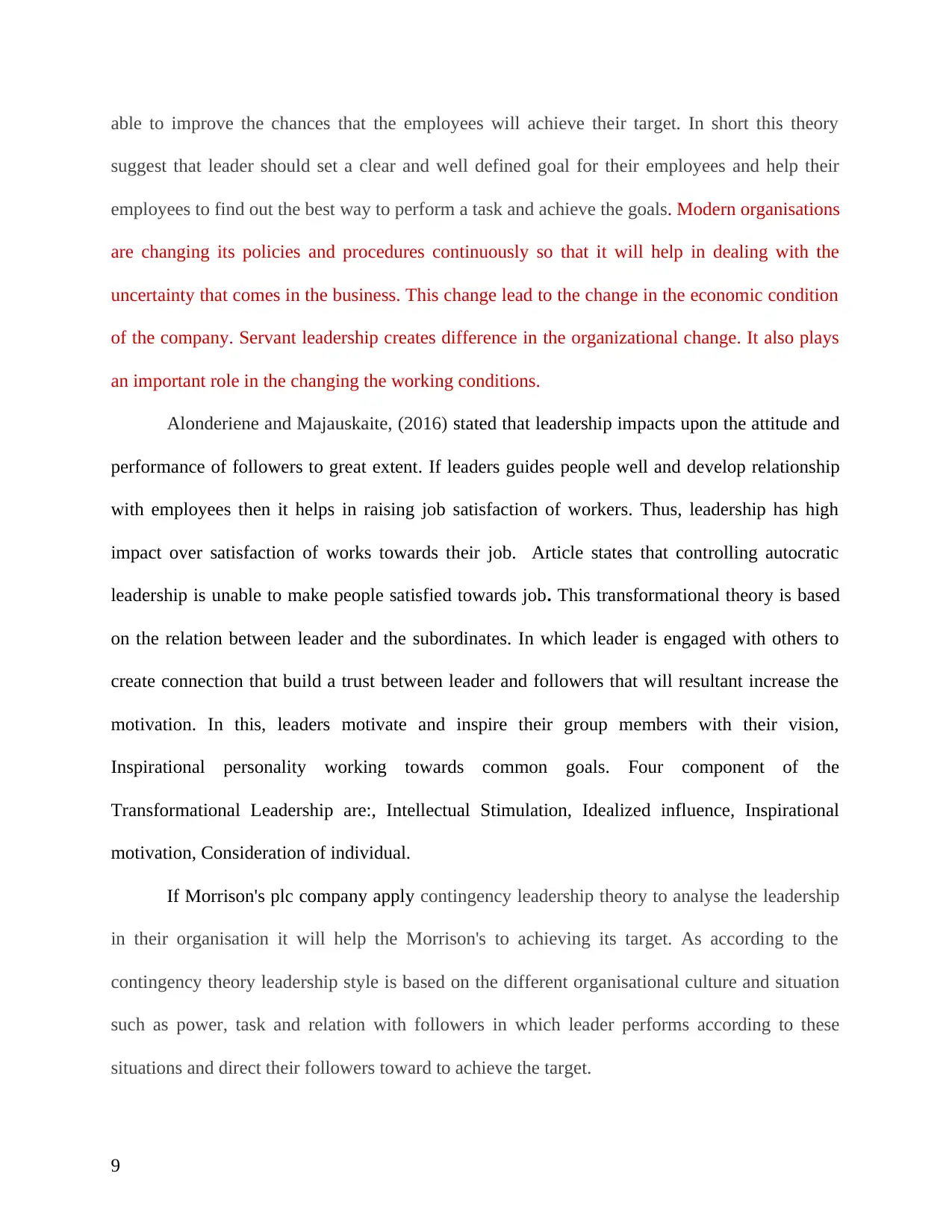
able to improve the chances that the employees will achieve their target. In short this theory
suggest that leader should set a clear and well defined goal for their employees and help their
employees to find out the best way to perform a task and achieve the goals. Modern organisations
are changing its policies and procedures continuously so that it will help in dealing with the
uncertainty that comes in the business. This change lead to the change in the economic condition
of the company. Servant leadership creates difference in the organizational change. It also plays
an important role in the changing the working conditions.
Alonderiene and Majauskaite, (2016) stated that leadership impacts upon the attitude and
performance of followers to great extent. If leaders guides people well and develop relationship
with employees then it helps in raising job satisfaction of workers. Thus, leadership has high
impact over satisfaction of works towards their job. Article states that controlling autocratic
leadership is unable to make people satisfied towards job. This transformational theory is based
on the relation between leader and the subordinates. In which leader is engaged with others to
create connection that build a trust between leader and followers that will resultant increase the
motivation. In this, leaders motivate and inspire their group members with their vision,
Inspirational personality working towards common goals. Four component of the
Transformational Leadership are:, Intellectual Stimulation, Idealized influence, Inspirational
motivation, Consideration of individual.
If Morrison's plc company apply contingency leadership theory to analyse the leadership
in their organisation it will help the Morrison's to achieving its target. As according to the
contingency theory leadership style is based on the different organisational culture and situation
such as power, task and relation with followers in which leader performs according to these
situations and direct their followers toward to achieve the target.
9
suggest that leader should set a clear and well defined goal for their employees and help their
employees to find out the best way to perform a task and achieve the goals. Modern organisations
are changing its policies and procedures continuously so that it will help in dealing with the
uncertainty that comes in the business. This change lead to the change in the economic condition
of the company. Servant leadership creates difference in the organizational change. It also plays
an important role in the changing the working conditions.
Alonderiene and Majauskaite, (2016) stated that leadership impacts upon the attitude and
performance of followers to great extent. If leaders guides people well and develop relationship
with employees then it helps in raising job satisfaction of workers. Thus, leadership has high
impact over satisfaction of works towards their job. Article states that controlling autocratic
leadership is unable to make people satisfied towards job. This transformational theory is based
on the relation between leader and the subordinates. In which leader is engaged with others to
create connection that build a trust between leader and followers that will resultant increase the
motivation. In this, leaders motivate and inspire their group members with their vision,
Inspirational personality working towards common goals. Four component of the
Transformational Leadership are:, Intellectual Stimulation, Idealized influence, Inspirational
motivation, Consideration of individual.
If Morrison's plc company apply contingency leadership theory to analyse the leadership
in their organisation it will help the Morrison's to achieving its target. As according to the
contingency theory leadership style is based on the different organisational culture and situation
such as power, task and relation with followers in which leader performs according to these
situations and direct their followers toward to achieve the target.
9
⊘ This is a preview!⊘
Do you want full access?
Subscribe today to unlock all pages.

Trusted by 1+ million students worldwide
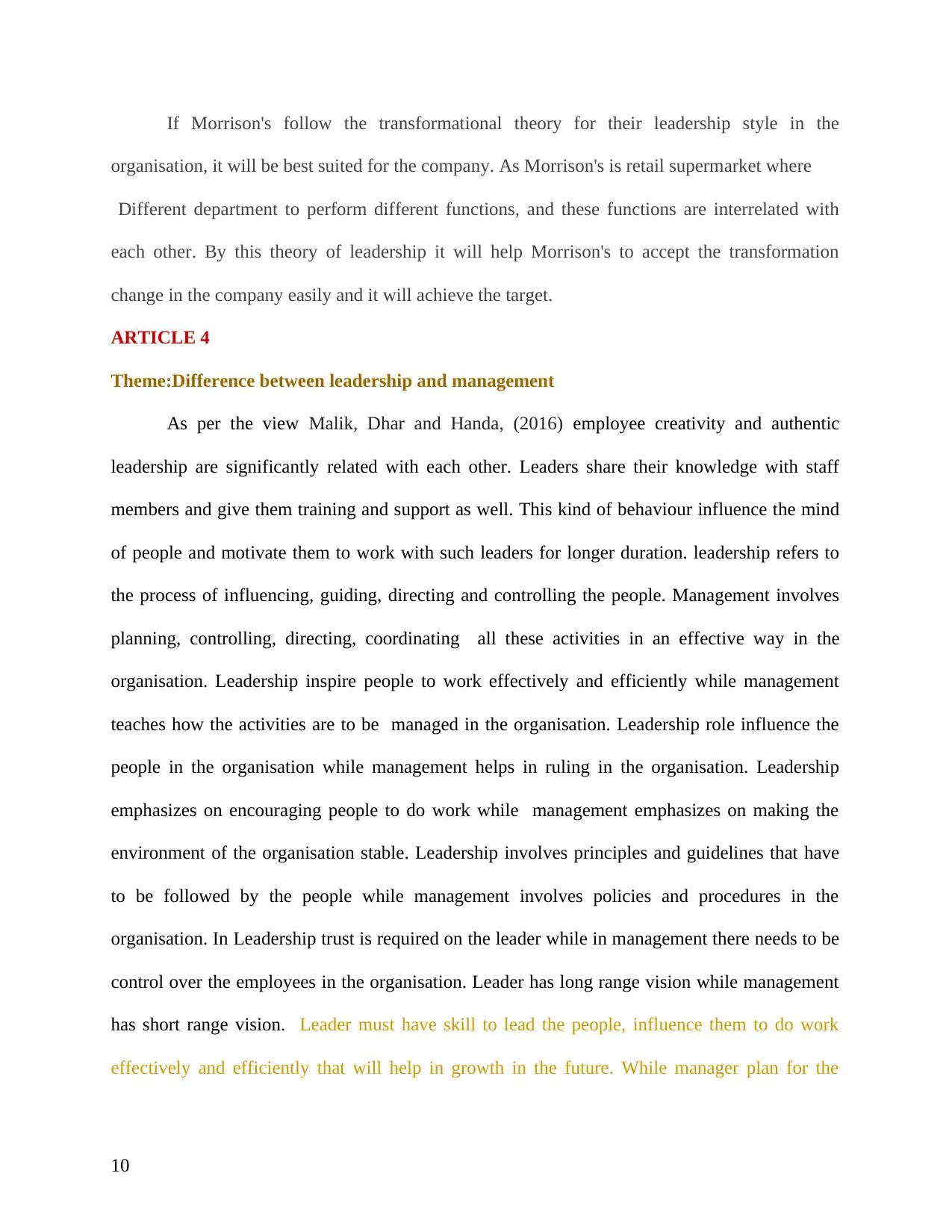
If Morrison's follow the transformational theory for their leadership style in the
organisation, it will be best suited for the company. As Morrison's is retail supermarket where
Different department to perform different functions, and these functions are interrelated with
each other. By this theory of leadership it will help Morrison's to accept the transformation
change in the company easily and it will achieve the target.
ARTICLE 4
Theme:Difference between leadership and management
As per the view Malik, Dhar and Handa, (2016) employee creativity and authentic
leadership are significantly related with each other. Leaders share their knowledge with staff
members and give them training and support as well. This kind of behaviour influence the mind
of people and motivate them to work with such leaders for longer duration. leadership refers to
the process of influencing, guiding, directing and controlling the people. Management involves
planning, controlling, directing, coordinating all these activities in an effective way in the
organisation. Leadership inspire people to work effectively and efficiently while management
teaches how the activities are to be managed in the organisation. Leadership role influence the
people in the organisation while management helps in ruling in the organisation. Leadership
emphasizes on encouraging people to do work while management emphasizes on making the
environment of the organisation stable. Leadership involves principles and guidelines that have
to be followed by the people while management involves policies and procedures in the
organisation. In Leadership trust is required on the leader while in management there needs to be
control over the employees in the organisation. Leader has long range vision while management
has short range vision. Leader must have skill to lead the people, influence them to do work
effectively and efficiently that will help in growth in the future. While manager plan for the
10
organisation, it will be best suited for the company. As Morrison's is retail supermarket where
Different department to perform different functions, and these functions are interrelated with
each other. By this theory of leadership it will help Morrison's to accept the transformation
change in the company easily and it will achieve the target.
ARTICLE 4
Theme:Difference between leadership and management
As per the view Malik, Dhar and Handa, (2016) employee creativity and authentic
leadership are significantly related with each other. Leaders share their knowledge with staff
members and give them training and support as well. This kind of behaviour influence the mind
of people and motivate them to work with such leaders for longer duration. leadership refers to
the process of influencing, guiding, directing and controlling the people. Management involves
planning, controlling, directing, coordinating all these activities in an effective way in the
organisation. Leadership inspire people to work effectively and efficiently while management
teaches how the activities are to be managed in the organisation. Leadership role influence the
people in the organisation while management helps in ruling in the organisation. Leadership
emphasizes on encouraging people to do work while management emphasizes on making the
environment of the organisation stable. Leadership involves principles and guidelines that have
to be followed by the people while management involves policies and procedures in the
organisation. In Leadership trust is required on the leader while in management there needs to be
control over the employees in the organisation. Leader has long range vision while management
has short range vision. Leader must have skill to lead the people, influence them to do work
effectively and efficiently that will help in growth in the future. While manager plan for the
10
Paraphrase This Document
Need a fresh take? Get an instant paraphrase of this document with our AI Paraphraser
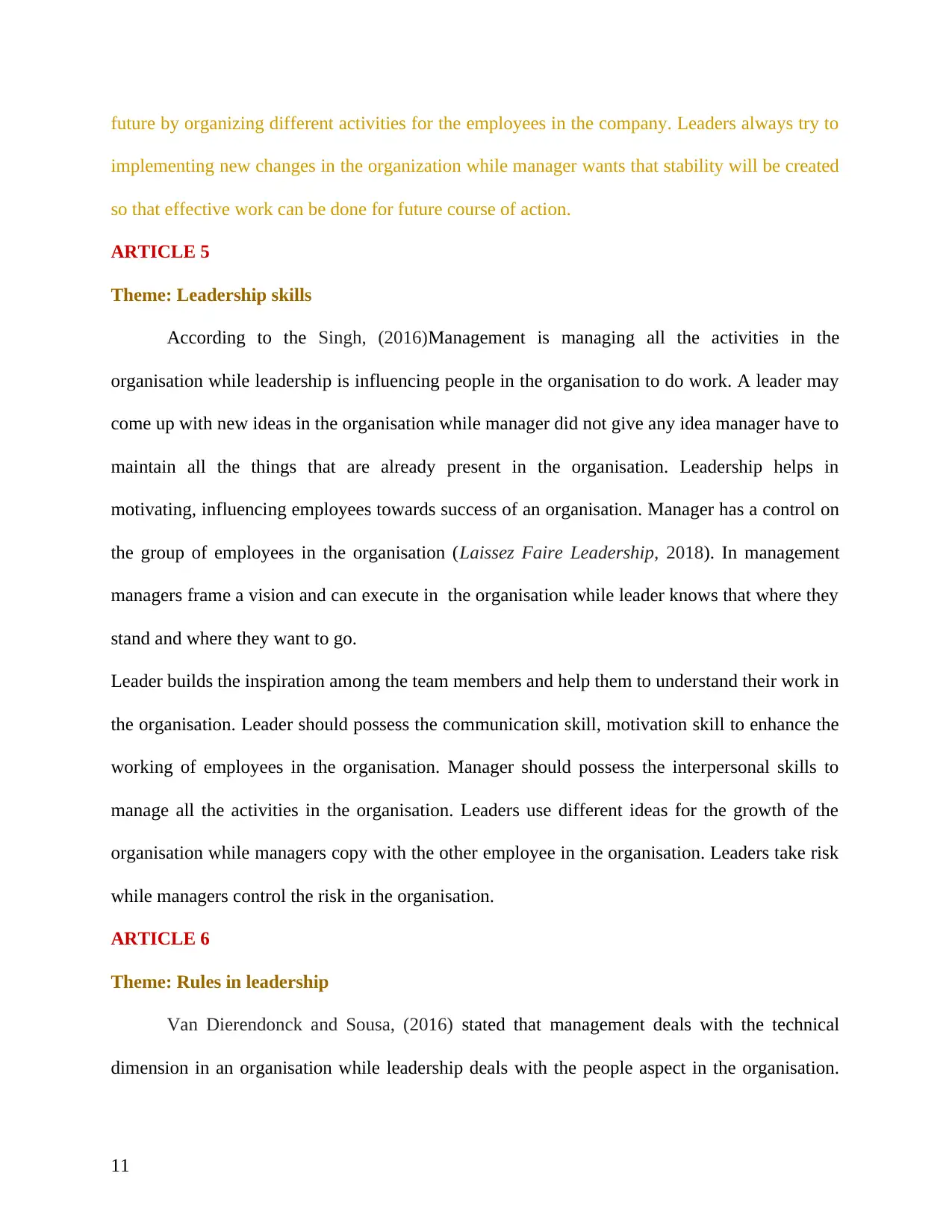
future by organizing different activities for the employees in the company. Leaders always try to
implementing new changes in the organization while manager wants that stability will be created
so that effective work can be done for future course of action.
ARTICLE 5
Theme: Leadership skills
According to the Singh, (2016)Management is managing all the activities in the
organisation while leadership is influencing people in the organisation to do work. A leader may
come up with new ideas in the organisation while manager did not give any idea manager have to
maintain all the things that are already present in the organisation. Leadership helps in
motivating, influencing employees towards success of an organisation. Manager has a control on
the group of employees in the organisation (Laissez Faire Leadership, 2018). In management
managers frame a vision and can execute in the organisation while leader knows that where they
stand and where they want to go.
Leader builds the inspiration among the team members and help them to understand their work in
the organisation. Leader should possess the communication skill, motivation skill to enhance the
working of employees in the organisation. Manager should possess the interpersonal skills to
manage all the activities in the organisation. Leaders use different ideas for the growth of the
organisation while managers copy with the other employee in the organisation. Leaders take risk
while managers control the risk in the organisation.
ARTICLE 6
Theme: Rules in leadership
Van Dierendonck and Sousa, (2016) stated that management deals with the technical
dimension in an organisation while leadership deals with the people aspect in the organisation.
11
implementing new changes in the organization while manager wants that stability will be created
so that effective work can be done for future course of action.
ARTICLE 5
Theme: Leadership skills
According to the Singh, (2016)Management is managing all the activities in the
organisation while leadership is influencing people in the organisation to do work. A leader may
come up with new ideas in the organisation while manager did not give any idea manager have to
maintain all the things that are already present in the organisation. Leadership helps in
motivating, influencing employees towards success of an organisation. Manager has a control on
the group of employees in the organisation (Laissez Faire Leadership, 2018). In management
managers frame a vision and can execute in the organisation while leader knows that where they
stand and where they want to go.
Leader builds the inspiration among the team members and help them to understand their work in
the organisation. Leader should possess the communication skill, motivation skill to enhance the
working of employees in the organisation. Manager should possess the interpersonal skills to
manage all the activities in the organisation. Leaders use different ideas for the growth of the
organisation while managers copy with the other employee in the organisation. Leaders take risk
while managers control the risk in the organisation.
ARTICLE 6
Theme: Rules in leadership
Van Dierendonck and Sousa, (2016) stated that management deals with the technical
dimension in an organisation while leadership deals with the people aspect in the organisation.
11
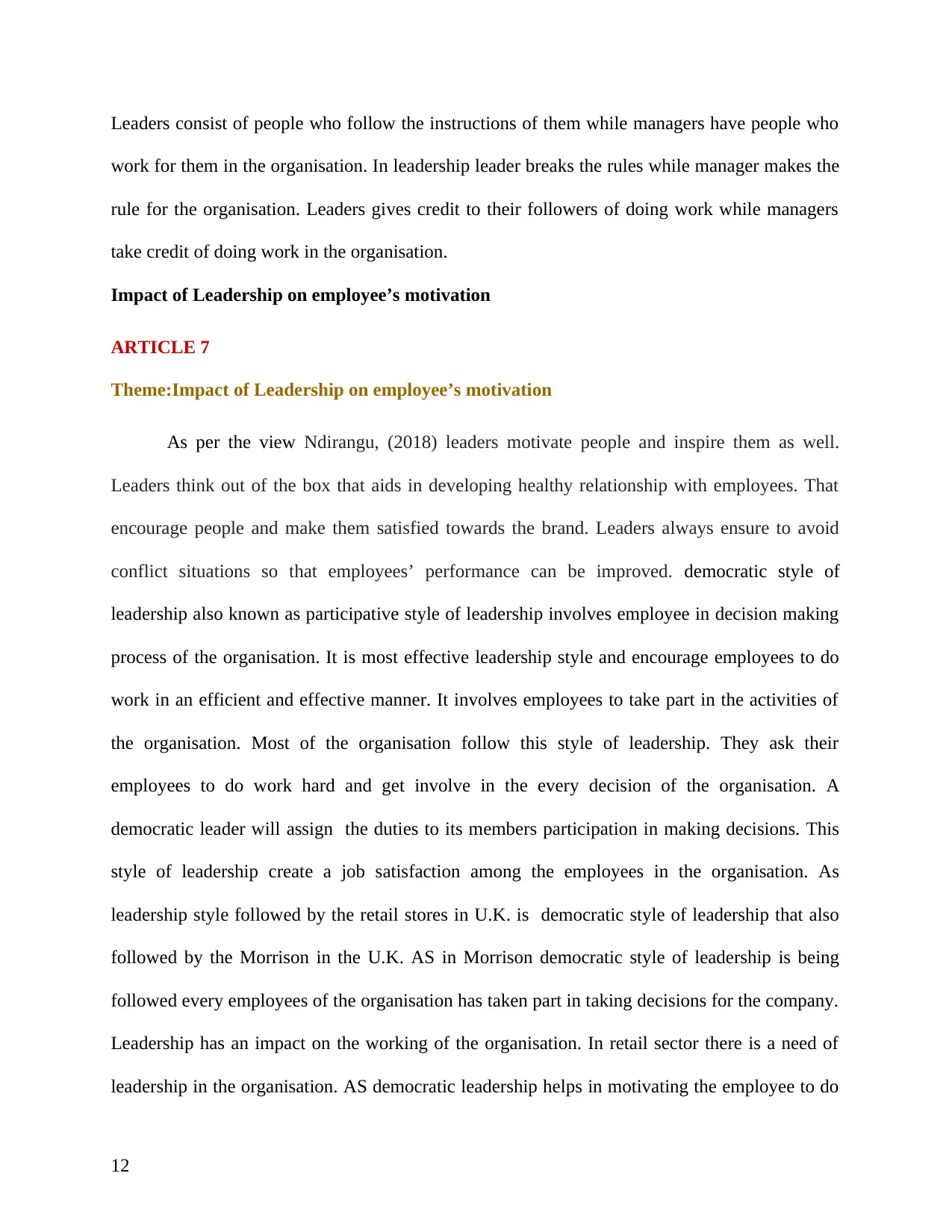
Leaders consist of people who follow the instructions of them while managers have people who
work for them in the organisation. In leadership leader breaks the rules while manager makes the
rule for the organisation. Leaders gives credit to their followers of doing work while managers
take credit of doing work in the organisation.
Impact of Leadership on employee’s motivation
ARTICLE 7
Theme:Impact of Leadership on employee’s motivation
As per the view Ndirangu, (2018) leaders motivate people and inspire them as well.
Leaders think out of the box that aids in developing healthy relationship with employees. That
encourage people and make them satisfied towards the brand. Leaders always ensure to avoid
conflict situations so that employees’ performance can be improved. democratic style of
leadership also known as participative style of leadership involves employee in decision making
process of the organisation. It is most effective leadership style and encourage employees to do
work in an efficient and effective manner. It involves employees to take part in the activities of
the organisation. Most of the organisation follow this style of leadership. They ask their
employees to do work hard and get involve in the every decision of the organisation. A
democratic leader will assign the duties to its members participation in making decisions. This
style of leadership create a job satisfaction among the employees in the organisation. As
leadership style followed by the retail stores in U.K. is democratic style of leadership that also
followed by the Morrison in the U.K. AS in Morrison democratic style of leadership is being
followed every employees of the organisation has taken part in taking decisions for the company.
Leadership has an impact on the working of the organisation. In retail sector there is a need of
leadership in the organisation. AS democratic leadership helps in motivating the employee to do
12
work for them in the organisation. In leadership leader breaks the rules while manager makes the
rule for the organisation. Leaders gives credit to their followers of doing work while managers
take credit of doing work in the organisation.
Impact of Leadership on employee’s motivation
ARTICLE 7
Theme:Impact of Leadership on employee’s motivation
As per the view Ndirangu, (2018) leaders motivate people and inspire them as well.
Leaders think out of the box that aids in developing healthy relationship with employees. That
encourage people and make them satisfied towards the brand. Leaders always ensure to avoid
conflict situations so that employees’ performance can be improved. democratic style of
leadership also known as participative style of leadership involves employee in decision making
process of the organisation. It is most effective leadership style and encourage employees to do
work in an efficient and effective manner. It involves employees to take part in the activities of
the organisation. Most of the organisation follow this style of leadership. They ask their
employees to do work hard and get involve in the every decision of the organisation. A
democratic leader will assign the duties to its members participation in making decisions. This
style of leadership create a job satisfaction among the employees in the organisation. As
leadership style followed by the retail stores in U.K. is democratic style of leadership that also
followed by the Morrison in the U.K. AS in Morrison democratic style of leadership is being
followed every employees of the organisation has taken part in taking decisions for the company.
Leadership has an impact on the working of the organisation. In retail sector there is a need of
leadership in the organisation. AS democratic leadership helps in motivating the employee to do
12
⊘ This is a preview!⊘
Do you want full access?
Subscribe today to unlock all pages.

Trusted by 1+ million students worldwide
1 out of 30
Related Documents
Your All-in-One AI-Powered Toolkit for Academic Success.
+13062052269
info@desklib.com
Available 24*7 on WhatsApp / Email
![[object Object]](/_next/static/media/star-bottom.7253800d.svg)
Unlock your academic potential
Copyright © 2020–2025 A2Z Services. All Rights Reserved. Developed and managed by ZUCOL.





